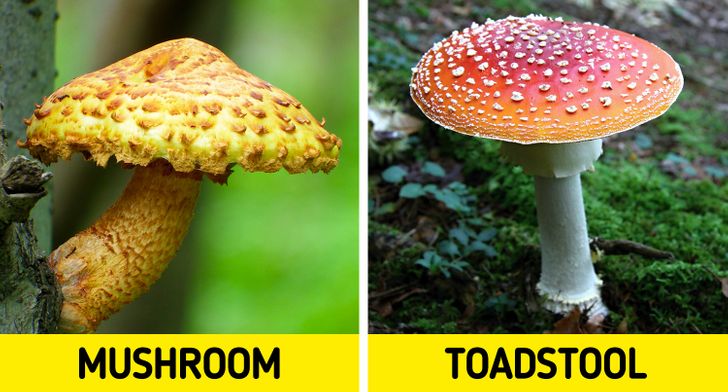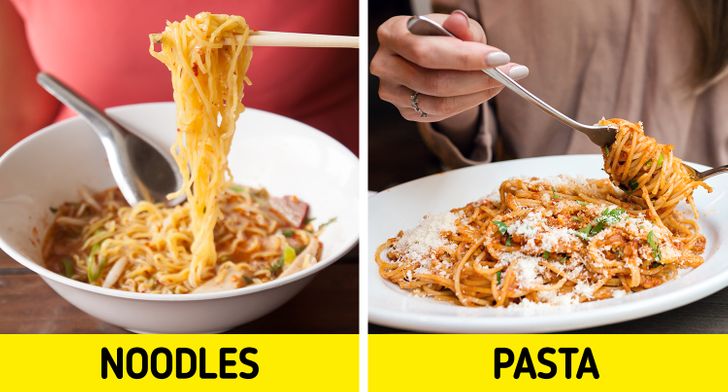Oh I didn't knew that Indian roti & tortilla were different!!
15 Foods That Are Often Mistaken for One Another, and How to Tell the Difference
Whether they share similar names or looks, some products can be hard to differentiate. A small mistake can confuse and surprise your taste buds. Let’s see if we can help you avoid this problem.
Bright Side chose some food pairs that get confused most often, and we can’t wait to share how you can finally tell them apart.
1. Mushroom vs toadstool
The toadstool has a rounded cap located on a stalk and it’s inedible. The mushroom takes the form of a domed cap, with gills on the other side of the cap, and it’s safe to eat. That’s why usually, people use the term “mushroom” to describe fungi that are edible, while “toadstool” refers to the kinds that are poisonous.
2. Plantain vs banana
3. Noodles vs pasta
Noodles and pasta are different due to their ingredients and the way they’re processed. Noodles are made of milled flour — most commonly, wheat. And salt must be added so that it can develop softer gluten and bind the dough. However, pasta uses a coarser type of flour and is processed into stiff and dry products that later must be boiled before eating.
4. Jam vs jelly
The most significant difference between jam and jelly is how much of the original fruit is in them. Jelly is made into a smoother consistency and it’s done by crushing the fruit and throwing away the solid chunks. Jams are made by the same process but most of the pieces and seeds are left inside to give it a more spreadable consistency.
5. Peach vs nectarine
The main difference between peaches and nectarines is that they have a different coating. Peaches have fuzzy skin and nectarines have a completely smooth coating. They can be used interchangeably for cooking, but since peaches have thicker coats, they need to be peeled.
6. Prawn vs shrimp
While shrimp and prawns are similar in taste, prawns are bigger in size and that’s why they’re considered more of a delicacy. So, because shrimp is smaller, it’s cooked a bit faster and they’re more commonly found on restaurant menus. There’s a difference in their names too, as “prawn” is used primarily in the United Kingdom, and “shrimp” is used more in North America.
7. Chickpea vs soybean
8. Cilantro vs parsley
9. Gelato vs ice cream
The main ingredient that makes up these 2 desserts is cream. However, the difference is the amount of fat that is used. To make gelato, you need less cream, more milk, and no egg yolks, which is one of the most common ingredients in ice cream. Another difference is the temperature: this popular treat is served around 0ºF, and gelato, at about 15ºF.
10. Yam vs sweet potato
The terms “yam” and “sweet potato” are used interchangeably for both veggies and this has caused a lot of confusion. The difference is that yams can grow to be very large and can weigh up to a whopping 132 lb. Yams, however, are rough and have a skin that is not easy to peel, but it can be after heating. On the other hand, sweet potatoes have smooth skin that can vary in color and they are sweeter, less dry, and starchy.
11. Cupcake vs muffin
The difference between muffins and cupcakes has nothing to do with their ingredients but with their mixing methods. Cupcakes are the miniature versions of cakes while muffins are mixed using the “muffin method,” no matter the flavor. This method consists of mixing the wet and dry ingredients in different bowls and then combining them. Also, muffins have less sugar, more whole grains, and more fruit — they can also be made savory and include things like veggies and cheese.
12. Indian roti vs tortilla
Roti and tortillas have different levels of fat. The tortilla is usually made using vegetable shortening or lard, while roti uses canola or vegetable oil. Also, roti dough is rougher than tortilla dough.
13. Cucumber vs zucchini
Cucumbers are cool, waxy, and hard while zucchinis are warmer to the touch and boast a slight grittiness on their skin. Also, most cucumbers have a rough, bumpy exterior, while zucchinis always have smoother skin. When it comes to taste, you’ll know that it’s a cucumber because it has that specific crunchiness.
14. Raw sugar vs brown sugar
Raw sugar has a mild caramel taste and the crystals are a light, golden brown. On the other side, brown sugar is darker and has a stickier texture with an undeniable caramel taste.
15. Macaroons vs macarons
The macaron is originally from France and consists of 2 light biscuits with a sweet ganache between them. Macaroons, however, contain shredded coconut as well as an egg mixture, and they’re baked into a fragrant, soft cookie.
Which food pair did you learn most about? Is there another food pair that you often are confused about? Do you have a few tricks that help you determine which one is which?
Comments
Had no idea that cupcakes and muffins were different from each other. I actually thought those were the same things!
Ok, the rest I understand, but who would mistake zucchini and and cucumber? :D
they don't even look similar!
they are both long and green :D
Paneer vs. tofu Octopus vs. squid Souffle vs. chocolate molton lava cake
Mousse vs. milkshake
Related Reads
12 Things Happy Couples Do, and If You Can Name at Least 3, You’re on the Right Path

Anne Hathaway Deemed Unrecognizable After Her Face Shocked Many in New Pics

I Publicly Humiliated My Stepmother After She Belittled My Late Mom

19 Houses and Apartments That Have More Secrets Than an Antique Casket

24 Stories That Prove Family Bonds Are Like No Other

My MIL Constantly Intrudes on My Privacy — I Installed a Hidden Camera Only to Discover a Shocking Mystery

19 Stepparents Who Proved Parenthood Is About Heart, Not DNA

10 Real Stories Too Dramatic for Daytime TV

A Woman Tried to Steal My Seat on the Plane Using an Unsettling Tactic

I Kicked My Stepdaughter Out — Her Behavior Was Turning Creepy

12 Big Purchases That Led to Unexpected Consequences

15+ Stories That Prove Moms’ Love Tank Never Runs Empty
















